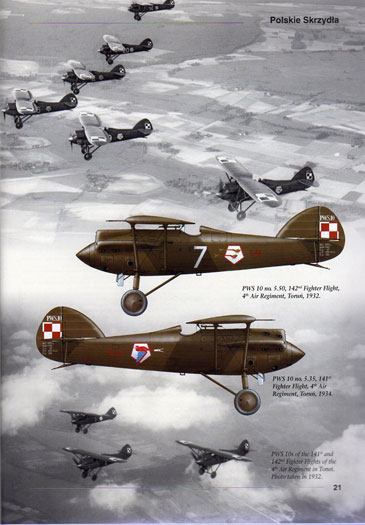|
S u m m a r y |
| Catalogue Number: |
Polskie Skrzyd?a 3 - Polish Wings 3
PWS-10 Avia BH-33 PZL P.7a
By: Tomasz J. Kopa?ski & Bart?omiej Belcarz
Stratus Books |
| ISBN: |
978-83-89450-89-0 |
| Media: |
Soft cover; A4 format; 56 pages plus covers |
| Price: |
GBP £9.90 from Mushroom Model Publications |
| Review Type: |
First Read |
| Advantages: |
Excellent color profiles and photographs and English text. |
| Disadvantages: |
No technical information |
| Conclusion: |
An overview of Poland’s interwar fighters with the emphasis on excellent photographs and profiles, but don't expect technical information |
Reviewed by Steven Eisenman

Polish Wings 3
is available online from Squadron
First, let me clarify that this monograph has not been lost in my review pile. While I did just review Polish Wings 8, it appears that Stratus has re-released some of the earlier Polish language only monographs in full English text. So after 8, there is 3, with regard to the English language editions.
Polish Wings 3 covers the development of three Polish built fighter aircraft, two of which were Polish designed, during the interwar period – the Avia BH.33/ PWA A, the PWS 10 and the PZL P.7.
 During the late 1920s, the Polish Air Force used the Spad 61 and 81 fighters. But, to read between the not so subtle lines, the Spads were just junk. They had a high accident rate, parts wore out quickly and there was a shortage of spare parts. During the late 1920s, the Polish Air Force used the Spad 61 and 81 fighters. But, to read between the not so subtle lines, the Spads were just junk. They had a high accident rate, parts wore out quickly and there was a shortage of spare parts.
Poland’s first efforts to create its own modern fighter grew out of its friendly technological relationship with Czechoslovakia. It seems that the Czechs were willing not only to make their newest fighter, the Avia BH.33 available to Poland under license production, but also make the design more modern. Under Polish manufacture, this aircraft became the PWS A (Type 4 aircraft) and entered service in 1930-1931, but in limited numbers.
Poland then ventured into designing its own fighter and the result was the PWS 10 (Type 5 aircraft), which was produced in greater numbers than the PWA A. These entered service in 1932. There is one interesting observation on the way aircraft design was carried out. It seems one of the major shortcomings of the PWS 10 was its high fuel consumption and, therefore, its short range. The fix was to put in a larger fuel tank. Of course, and left unsaid, was that this would increase weight and reduce speed.
The final aircraft covered by the monograph is the PZL P.7a (Type 6 aircraft), the famous inverted gull wing creation of Zygmunt Pulawski. The P.7a began production in 1932 and ended in 1933,with 150 aircraft being produced. Although out classed, and replaced by the PZL P.11, by the beginning of the Second World War, the P. 7a was credited with seven kills, including a Bf 110, but none against another single engine fighter.
The monograph covers all three aircraft in a similar manner. There is a brief overview of the development of the aircraft. This is followed by a short service history of the type. In the case of the PWS 10, there is also an interesting discussion of is “illegal” sale to and use by the Spanish Nationalists. For each of the three aircraft, there is a service record of each aircraft produced.
There is a brief description of camouflage and markings. In the case of the camouflage it can be summed up in one word: Khaki. Although to be fair, the PZL P.7A did have light blue undersides - for something completely different.
Finally there are the photographs and profiles. As has always been the case with the Polish Wings series, the photographs are amazingly quite extensive, given the time period. The profiles are uniformly excellent and are supported by the photographs.
What I do find most annoying is the absence of any technical information. We learn nothing about the armament these fighter had or what ordnance they could carry. There is nothing about the engines, speed, range, dimensions, etc. Even a simple chart listing the characteristics of each of the three aircraft would have added greatly to our knowledge.
For modelers there is a tie-in with Techmod decals. Techmod produced a sheet of 1/72 decals (No. 72140A) for the PZL P.7A, based on the profiles in this Polish Wings monograph. However, the decals must be purchased separately. As for a model of the P.7A, there appears to be only a 1/72 scale kit from Mastercraft, and it seems to be only available on ebay.
For those seeking an overview of Poland’s interwar fighters with the emphasis on excellent photographs and profiles, Polish Wings 3 will be of interest to you. But if you are looking for more about the aircraft, then it will not meet your expectations.
All Mushroom Model Publications books are available direct from the publishers, who now accept credit cards (Visa, MC, Amex, Switch)
Thanks to Roger at Mushroom Model Magazine for the sample.
All Mushroom Model
Publications books are
available direct from
the publishers,
who now accept credit cards (Visa, MC, Amex, Switch)
North American
distributors are MMD, Australian distributors are Platypus
Publications. In Europe, the books are available from any good bookshop (via our
UK distributors, Orca). Contact MMP direct in case of difficulties.
Thanks to
Roger at Mushroom Model
Magazine for
the sample.
Review Copyright 2008 by Steven Eisenman
This Page Created on 10 December, 2008
Last updated
10 December, 2008
Back to HyperScale Main Page
Back to Reviews Page
|
